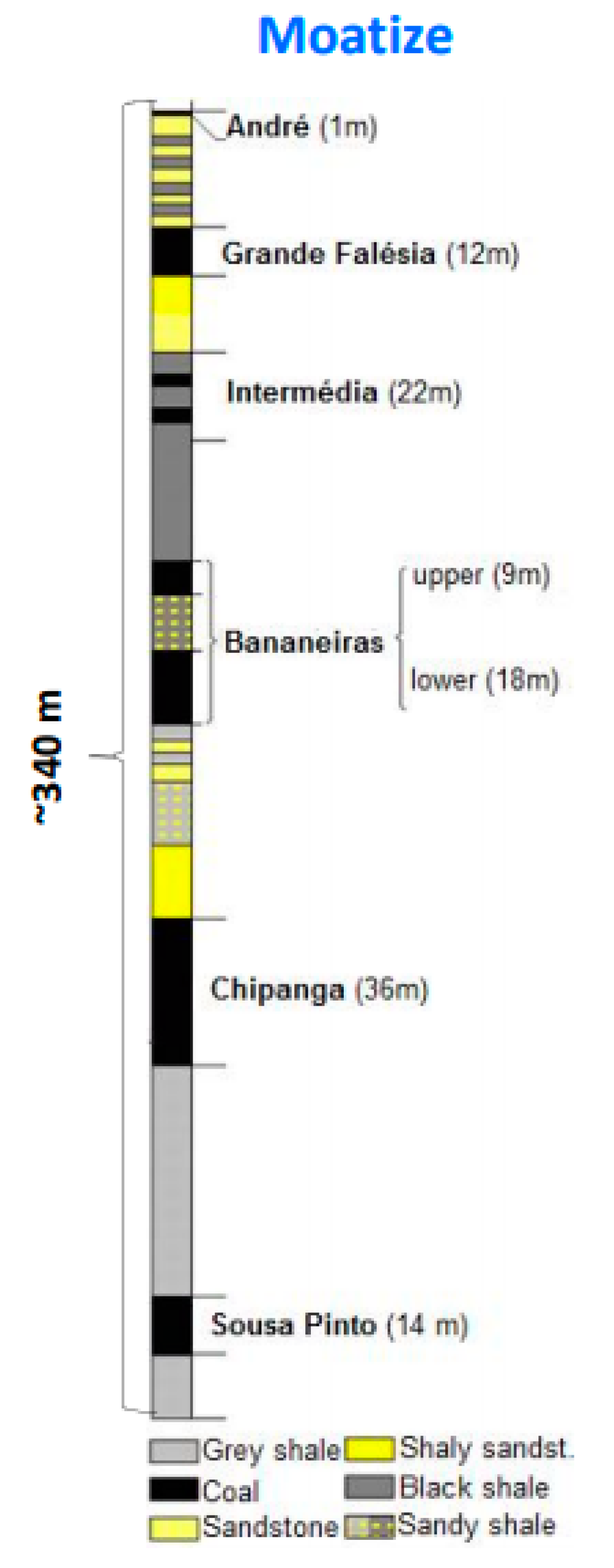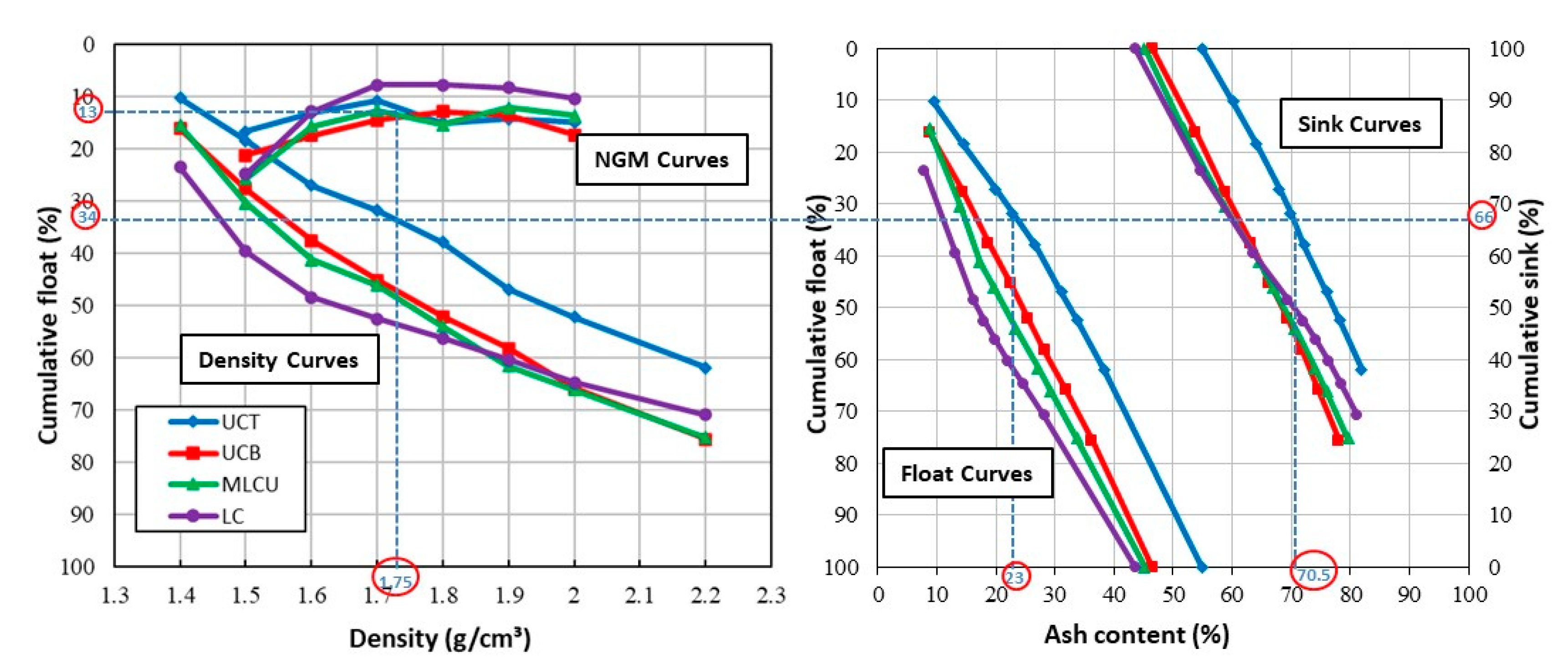Destoning the Moatize Coal Seam, Mozambique, by Dry Jigging
Abstract
1. Introduction
1.1. Coal Basin and Coal Mine
1.2. Coal Destoning
2. Materials and Methods
2.1. Coal Samples
2.2. Density Distribution Test
2.3. Jigging Tests
3. Results and Discussion
3.1. Size Distribution
3.2. Density Distribution
3.3. Sulfur Distribution
3.4. Stratification Profiles
3.5. Destoning Considerations
4. Conclusions
Author Contributions
Funding
Acknowledgments
Conflicts of Interest
References
- Statista. Global Coke Production 1993 to 2018 (in Million Metric Tons). Available online: https://www.statista.com/statistics/267891/global-coke-production-since-1993 (accessed on 27 July 2020).
- Statista. World Crude Steel Production from 2012 to 2019 (in Million Metric Tons). Available online: https://www.statista.com/statistics/267264/world-crude-steel-production/ (accessed on 27 July 2020).
- Díez, M.A.; Alvarez, R.; Barriocanal, C. Coal for metallurgical coke production: Predictions of coke quality and future requirements for cokemaking. Int. J. Coal Geol. 2002, 50, 389–412. [Google Scholar] [CrossRef]
- Hatton, W.; Fardell, A. New discoveries of coal in Mozambique: Development of the coal resource estimation methodology for International Resource Reporting Standards. Int. J. Coal Geol. 2012, 89, 2–12. [Google Scholar] [CrossRef]
- Vasconcelos, L.; Muchangos, A.; Siquela, E. Elementos traços em cinzas de carvões aflorantes de Moçambique. Geochim. Bras. 2009, 23, 344–361. [Google Scholar]
- Cairncross, B. An overview of the Permian (Karoo) coal deposits of southern Africa. Afr. Earth Sci. 2001, 33, 529–562. [Google Scholar] [CrossRef]
- Lakshminarayana, G. Geology of Barcode type coking coal seams, Mecondezi sub-basin, Moatize Coalfield, Mozambique. Int. J. Coal Geol. 2015, 146, 1–13. [Google Scholar] [CrossRef]
- Vasconcelos, L. Geologia do Carvão: Caracterização geológica da Bacia de Moatize-Moçambique; UEM Universidade Eduardo Mondlane: Maputo, Mozambique, 2005. (In Portuguese) [Google Scholar]
- Vale. 2018. Available online: http://www.vale.com/mozambique/PT/business/mining/coal/moatize-coal-mine/Paginas/default.aspx (accessed on 10 November 2018).
- José, D.S. Caracterização Tecnológica de Carvão ROM da Mina de Moatize–Moçambique Para o “Destoning”, Visando Seu Beneficiamento. Ph.D. Thesis, Universidade Federal do Rio Grande do Sul, Porto Alegre, Brazil, 2018; p. 223. (In Portuguese). [Google Scholar]
- Wills, B.A.; Finch, J.A. Mineral Processing Technology: An Introduction to the Practical Aspects of Ore Treatment and Mineral Recovery, 8th ed.; Butterworth-Heinemann: Oxford, UK, 2016. [Google Scholar]
- Charan, G.T.; Chattopadhyay, U.S.; Singh, K.M.P.; Kabiraj, S.; Haldar, D.D. Pilot-Scale Baum Jig Washing for Beneficiation of a High-Ash Indian Non coking Coal. Int. J. Coal Prep. Util. 2009, 29, 130–139. [Google Scholar] [CrossRef]
- Dwari, R.K.; Rao, K.H. Dry beneficiation of coal—A review. Miner. Process. Extr. Metall. Rev. 2007, 28, 177–234. [Google Scholar] [CrossRef]
- Xia, W.; Xie, G.; Peng, Y. Recent advances in beneficiation for low rank coals. Powder Technol. 2015, 277, 206–221. [Google Scholar] [CrossRef]
- Sampaio, C.H.; Aliaga, W.; Pacheco, E.T.; Petter, E.; Wotruba, H. Coal beneficiation of Candiota mine by dry jigging. Fuel Process. Technol. 2008, 89, 198–202. [Google Scholar] [CrossRef]
- Boylu, F.; Talı, E.; Çetinel, T.; Çelik, M.S. Effect of fluidizing characteristics on upgrading of lignitic coals in gravity based air jig. Int. J. Miner. Process. 2014, 129, 27–35. [Google Scholar] [CrossRef]
- Charan, T.G.; Chattopadhyay, U.S.; Singh, K.M.P.; Kabiraj, S.K.; Haldar, D.D. Beneficiation of high-ash, Indian non-coking coal by dry jigging. Min. Metall. Explor. 2011, 28, 21–23. [Google Scholar]
- Boylu, F.; Çinku, K.; Çetinel, T.; Karakaş, F.; Güven, O.; Karaağaçlioğlu, I.E.; Çelik, M.S. Effect of coal moisture on the treatment of a lignitic coal through a semi-pilot-scale pneumatic stratification jig. Int. J. Coal Prep. Util. 2015, 35, 143–154. [Google Scholar] [CrossRef]
- Ihedioha, J.I.; Okorie-kanu, C.O.; Iwuogo, U.M. Upgrading coal using a pneumatic density based separator. Int. J. Coal Prep. Util. 2008, 28, 51–67. [Google Scholar]
- Zhao, Y.; Fu, Z.; Yang, L.Z.; Duan, C.; Song, S.; Cai, L. Fine Coal Dry Cleaning using an Air Dense Medium Fluidized Bed with Improved Magnetite Medium. Procedia Eng. 2015, 102, 1133–1141. [Google Scholar] [CrossRef]
- Fu, Z.; Zhao, Y.; Yang, X.; Luo, Z.; Zhao, J. Fine coal beneficiation via air-dense medium fluidized beds with improved magnetite powders. Int. J. Coal Prep. Util. 2016, 36, 55–68. [Google Scholar] [CrossRef]
- Xu, X.; Chen, J.; Luo, Z.; Tang, L.; Zhao, Y.; Lv, B.; Fu, Y.; Chen, C. Fluidization Characteristics of Air Dense Medium Agitated Separation Fluidized Bed with Different Distributors. Miner. Process. Extr. Metall. Rev. 2019, 40, 299–306. [Google Scholar] [CrossRef]
- Nienhaus, K.; Pretz, T.; Wotruba, H. Sensor Technologies: Impulses for the Raw Materials Industry; Shaker Verlag GmbH: Düren, Germany, 2014; p. 476. [Google Scholar]
- Duan, C.-L.; He, Y.-Q.; Zhao, Y.-M.; He, J.-F.; Wen, B.F. Development and application of the active pulsing air classification. Proceed Earth Planet. Sci. 2009, 1, 667–672. [Google Scholar]
- Das, A.; Sarkar, B. Advanced gravity concentration of fine particles: A review. Miner. Process.Extr. Metall. Rev. 2018, 39, 359–394. [Google Scholar] [CrossRef]
- Weinstein, R.; Snoby, R. Advances in dry jigging improves coal quality. Min. Eng. 2007, 1, 29–34. [Google Scholar]
- Snoby, R.; Thompson, K.; Mishra, S.; Snoby, B. Dry jigging coal: Case history performance. In Proceedings of the 2009 SME Annual Meeting, Denver, CO, USA, 22–25 February 2009. [Google Scholar]
- Ambrós, W.M.; Sampaio, C.H.; Cazacliu, B.G.; Conceição, P.N.; Reis, G.S. Some observations on the influence of particle size and size distribution on stratification in pneumatic jigs. Powder Technol. 2019, 342, 594–606. [Google Scholar] [CrossRef]
- Bird, B.M. Interpretation of float-and-sink data, Anais, II. Int. Conf. Bitum. Coal 1928, 2, 82–111. [Google Scholar]




| Size Range | |||
|---|---|---|---|
| Coal Seam | 50 mm × 1 mm | <1 mm | Total |
| UCT | 79.12 | 20.88 | 100 |
| UCB | 79.11 | 20.89 | 100 |
| MLCU | 81.74 | 18.26 | 100 |
| LC | 68.74 | 31.26 | 100 |
| Density (δ) Range (g/cm3) | Sulfur Content (weight %) | |||
|---|---|---|---|---|
| UCT | UCB | MLCU | LC | |
| δ < 1.4 | 0.9 | 0.9 | 0.5 | 0.5 |
| 1.4 < δ < 1.5 | 1.0 | 0.8 | 0.6 | 0.6 |
| 1.5 < δ < 1.6 | 0.9 | 0.7 | 0.6 | 0.6 |
| 1.6 < δ < 1.7 | 0.7 | 0.6 | 0.5 | 0.5 |
| 1.7 < δ < 1.8 | 0.8 | 0.6 | 0.6 | 0.6 |
| 1.8 < δ < 1.9 | 0.5 | 0.6 | 0.4 | 0.4 |
| 1.9 < δ < 2.0 | 0.5 | 0.3 | 0.5 | 0.5 |
| 2.0 < δ < 2.2 | 0.9 | 0.3 | 1.1 | 1.1 |
| Δ > 2.2 | 0.8 | 0.6 | 0.5 | 0.5 |
| Density Range | Total | ||||
|---|---|---|---|---|---|
| δ < 1.6 g/cm3 | 1.6 < δ < 2.2 g/cm3 | δ > 2.2 g/cm3 | |||
| Mass (wt%) | Mass (wt%) | Mass (wt%) | |||
| Sep. Section 1 (S1) | 18.4 | 69.1 | 12.5 | 100 | |
| Coal Layer—UCT | Sep. Section 2 (S2) | 12.2 | 32.3 | 55.5 | 100 |
| Sep. Section 3 (S3) | 0.0 | 40.6 | 59.4 | 100 | |
| Sep. Section 1 (S1) | 64.8 | 33.3 | 1.9 | 100 | |
| Coal Layer—MLCU | Sep. Section 2 (S2) | 26.6 | 58.3 | 15.1 | 100 |
| Sep. Section 3 (S3) | 12.0 | 53.9 | 34.1 | 100 | |
| Sep. Section 1 (S1) | 85.4 | 14.6 | 0.0 | 100 | |
| Coal Layer—LC | Sep. Section 2 (S2) | 29.7 | 55.4 | 14.9 | 100 |
| Sep. Section 3 (S3) | 9.0 | 24.9 | 66.1 | 100 | |
| Sep. Section 1 (S1) | 53.3 | 42.3 | 4.4 | 100 | |
| Coal Layer—UCB | Sep. Section 2 (S2) | 22.3 | 66.5 | 11.2 | 100 |
| Sep. Section 3 (S3) | 7.8 | 43.2 | 49.0 | 100 | |
| Density Range | ||||
|---|---|---|---|---|
| δ < 1.6 g/cm3 | 1.6 < δ < 2.2 g/cm3 | δ > 2.2 g/cm3 | ||
| Mass (wt%) | Mass (wt%) | Mass (wt%) | ||
| Coal Layer—UCT | Sep. Section 1 (S1) | 60.1 | 48.5 | 9.8 |
| Sep. Section 2 (S2) | 39.9 | 22.8 | 43.6 | |
| Sep. Section 3 (S3) | 0.0 | 28.7 | 46.6 | |
| Total | 100 | 100 | 100 | |
| Coal Layer—MLCU | Sep. Section 1 (S1) | 62.7 | 22.9 | 3.7 |
| Sep. Section 2 (S2) | 25.7 | 40.0 | 29.6 | |
| Sep. Section 3 (S3) | 11.6 | 37.1 | 66.7 | |
| Total | 100 | 100 | 100 | |
| Coal Layer—LC | Sep. Section 1 (S1) | 68.9 | 15.5 | 0.0 |
| Sep. Section 2 (S2) | 23.9 | 58.2 | 18.3 | |
| Sep. Section 3 (S3) | 7.2 | 26.3 | 81.7 | |
| Total | 100 | 100 | 100 | |
| Coal Layer—UCB | Sep. Section 1 (S1) | 63.9 | 27.8 | 6.8 |
| Sep. Section 2 (S2) | 26.8 | 43.8 | 17.4 | |
| Sep. Section 3 (S3) | 9.3 | 28.4 | 75.8 | |
| Total | 100 | 100 | 100 | |
| Coal Layer | Washability Curves | Coal Layers | Jigging Tests | ||||
|---|---|---|---|---|---|---|---|
| Mat δ > 2.2 g/cm3 | Ash Content | Layer Thickness | Mass in Seam | Mat δ > 2.2 g/cm3 | Mat δ > 2.2 g/cm3 | Mat δ > 2.2 g/cm3 | |
| (wt%) | (wt%) | (m) | (wt%) | (wt%) | Relat. Sink-Float | Relat. Coal Layer | |
| UCT | 38.10 | 81.90 | 4.08 | 13.92 | 46.60 | 17.75 | 2.47 |
| UCB | 24.40 | 78.04 | 11.80 | 40.25 | 75.80 | 18.50 | 7.44 |
| MLCU | 24.75 | 79.59 | 10.44 | 35.61 | 66.70 | 16.51 | 5.88 |
| LC | 29.13 | 81.13 | 3.00 | 19.23 | 81.70 | 23.80 | 2.44 |
| Total | 29.32 | 100.00 | 18.23 | ||||
© 2020 by the authors. Licensee MDPI, Basel, Switzerland. This article is an open access article distributed under the terms and conditions of the Creative Commons Attribution (CC BY) license (http://creativecommons.org/licenses/by/4.0/).
Share and Cite
Sampaio, C.H.; Ambrós, W.M.; Cazacliu, B.; Moncunill, J.O.; José, D.S.; Miltzarek, G.L.; Brum, I.A.S.d.; Petter, C.O.; Fernandes, E.Z.; Oliveira, L.F.S. Destoning the Moatize Coal Seam, Mozambique, by Dry Jigging. Minerals 2020, 10, 771. https://doi.org/10.3390/min10090771
Sampaio CH, Ambrós WM, Cazacliu B, Moncunill JO, José DS, Miltzarek GL, Brum IASd, Petter CO, Fernandes EZ, Oliveira LFS. Destoning the Moatize Coal Seam, Mozambique, by Dry Jigging. Minerals. 2020; 10(9):771. https://doi.org/10.3390/min10090771
Chicago/Turabian StyleSampaio, Carlos Hoffmann, Weslei Monteiro Ambrós, Bogdan Cazacliu, Josep Oliva Moncunill, David Selemane José, Gerson Luis Miltzarek, Irineu Antônio Schadach de Brum, Carlos Otávio Petter, Eunírio Zanetti Fernandes, and Luis Felipe Silva Oliveira. 2020. "Destoning the Moatize Coal Seam, Mozambique, by Dry Jigging" Minerals 10, no. 9: 771. https://doi.org/10.3390/min10090771
APA StyleSampaio, C. H., Ambrós, W. M., Cazacliu, B., Moncunill, J. O., José, D. S., Miltzarek, G. L., Brum, I. A. S. d., Petter, C. O., Fernandes, E. Z., & Oliveira, L. F. S. (2020). Destoning the Moatize Coal Seam, Mozambique, by Dry Jigging. Minerals, 10(9), 771. https://doi.org/10.3390/min10090771









